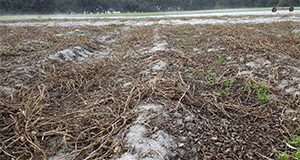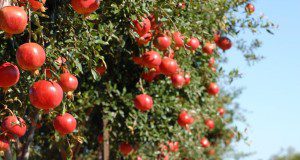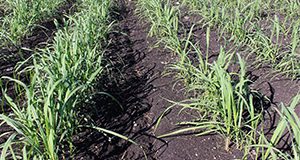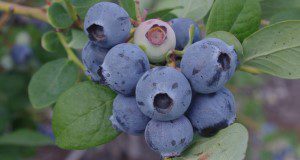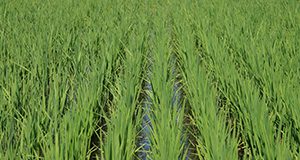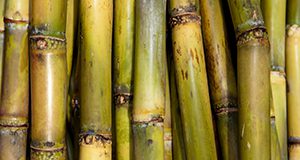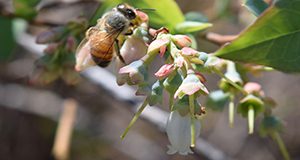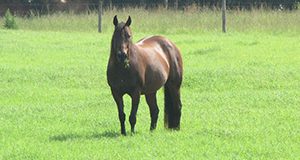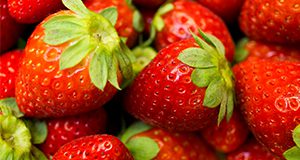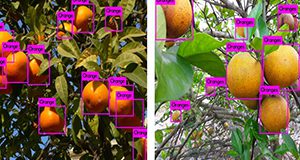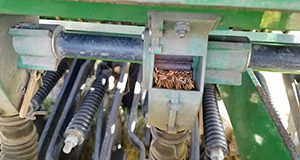There is not enough evidence to support current peanut N credit recommendations in the Southeast. Nitrogen is released rapidly from peanut residues, and it moves quickly through light-textured soils found in this region. Only a relatively small amount of N from peanut residues is available when subsequent crops need it. This new 5-page document discusses peanut nitrogen credits, nitrogen release from peanut residues, crop performance following peanut, tillage and nitrogen release, and peanut residue distribution and nitrogen release. Written by Arun Jani and Michael J. Mulvaney, and published by the UF/IFAS Agronomy Department, April 2019.
http://edis.ifas.ufl.edu/ag431
Category: Crops
La Granada en Florida: Una fruta de arbol para Florida?
El potencial económico en la producción comercial para el cultivo de granadas en Florida es actualmente desconocido en este momento. La investigación científica continúa sobre la posibilidad de encontrar variedades de granadas que puedan crecer en Florida. Las condiciones ambientales, con una alta temporada húmeda en la Florida, y un clima caluroso, son factores que son favorables para las enfermedades en las granadas y eso reduce la calidad de esta fruta, especialmente para las variedades de temporada tardía como la variedad ‘Wonderful’. ‘Wonderful’ es el principal cultivar comercial que se originó en la Florida. Para reducir las enfermedades y evitar la competencia de comercialización con las granadas de California, la investigación para la producción de granadas en la Florida debe centrarse en buscar variedades de temporada temprana que puedan cosecharse en julio y agosto. This six-page document is the Spanish translation of HS44, The Pomegranate. Written by Ali Sarkhosh and Jeff Williamson, translated by Eva Pabon, and published by the UF/IFAS Horticultural Sciences Department.
http://edis.ifas.ufl.edu/hs294
Food Safety on the Farm: Good Agricultural Practices and Good Handling Practices: Transportation
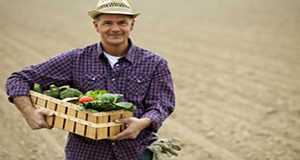
Good agricultural practices (GAPs) and good handling practices (GHPs) encompass the general procedures growers, packers, and processors of fresh fruits and vegetables should follow to ensure the safety of their product. GAPs usually address preharvest practices (i.e., in the field), while GHPs cover postharvest practices, including packing and shipping. This 3-page fact sheet covers the GAPs of transporting crops. This major revision is a part of the Food Safety on the Farm series and was written by Christopher R. Pabst, Jaysankar De, Alina Balaguero, Jessica Lepper, Renée Goodrich-Schneider, and Keith R. Schneider and published by the UF/IFAS Food Science and Human Nutrition Department.
http://edis.ifas.ufl.edu/fs151
Sugarcane Cultivar Descriptive Fact Sheet: CPCL 02-0926 and CP 05-1526
This new 5-page fact sheet provides basic information as well as yield and disease information for CPCL 02-0926 and CP 05-1526 to assist growers in selection and management of these cultivars. Written by Hardev Sandhu and Wayne Davidson, and published by the UF/IFAS Agronomy Department, February 2019.
http://edis.ifas.ufl.edu/sc105
Southern Highbush Blueberry Cultivars from the University of Florida
Southern highbush blueberries combine the fruit quality and productivity of highbush blueberries with the low chilling requirement necessary to produce a crop in the Florida climate. Written by J. G. Williamson, D. A. Phillips, P. M. Lyrene, and P. R. Munoz and published by the UF/IFAS Horticultural Sciences Department, this 13-page major revision describes current and historical southern highbush blueberry cultivars released by the University of Florida.
http://edis.ifas.ufl.edu/hs1245
Weed Management in Rice
Successful weed control is essential for economical rice production in Florida. This 6-page document discusses field sanitation and tillage, water management, and herbicides. Written by D. C. Odero and M. VanWeelden, and published by the UF/IFAS Agronomy Department, revised August 2018.
http://edis.ifas.ufl.edu/wg001
Sample Productivity and Cost Estimates of Producing Longan (Dimocarpus longan Lour.) in South Florida
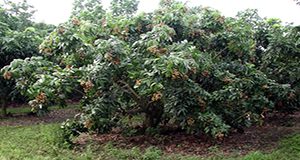
Interest is growing in minor tropical fruit crops. This 6-page publication written by Fredy H. Ballen, Edward A. Evans, Aditya Singh, and Jonathan H. Crane and published by the UF/IFAS Food and Resource Economics Department provides an estimate of the costs and returns associated with the operation of an established longan grove in south Florida. Information presented in this article was obtained through field interviews with growers and industry experts; it reflects a wide variety of production practices in small longan orchards of 1 to 4 acres and should help estimate the financial requirements of operating an established grove.
http://edis.ifas.ufl.edu/fe1049
Alpine Strawberry as a Potential Niche Crop for Florida Growers and Homeowners
Alpine strawberries (Fragaria vesca) produce edible and highly aromatic strawberries known for their excellent eating quality. The berries are fragile and not suitable for long-distance shipping, which inhibits trade on the international market but also provides an opportunity for growers catering to local markets and for homeowners interested in growing this unique and delicious strawberry. This 5-page fact sheet written by Alan Chambers and published by the UF/IFAS Horticultural Sciences Department describes yield and fruit quality for several varieties to guide potential growers. The results of this project are anticipated to benefit growers and homeowners looking to cultivate specialty alpine strawberries.
http://edis.ifas.ufl.edu/hs1326
Elemental Sulfur Recommendations for Sugarcane on Florida Organic Soils
Micronutrient deficiencies can be important limiting factors in alkaline soils, with most micronutrients becoming less available for plant uptake as soil pH increases. This 6-page document is intended primarily for Florida sugarcane growers but may also be useful to researchers and others interested in sugarcane nutrition. It presents revised elemental sulfur recommendations for sugarcane grown on Florida organic soils along with supporting information. Written by J. Mabry McCray, and published by the UF/IFAS Agronomy Department, February 2019.
http://edis.ifas.ufl.edu/ag429
Pollination Best Practices in Southern Highbush Blueberry in Florida
Southern highbush blueberry is the primary blueberry species grown in Florida. It is dependent upon pollinating insects for adequate pollination and fruit. Some Florida growers have reported cases of low fruit set in recent years, in particular on the cultivars Meadowlark and Emerald, which may have been due in part to poor pollination. This 5-page fact sheet written by Rachel E. Mallinger and Douglas A. Phillips and published by the UF/IFAS Department of Entomology and Nematology will discuss blueberry pollinators, some causes of poor pollination, and current best practices to reduce the possibility of poor pollination of southern highbush blueberry.
http://edis.ifas.ufl.edu/in1237
Potassium Fertilizer Recommendations for Sugarcane on Florida Organic Soils
Potassium is a primary plant nutrient that is required in large amounts by sugarcane. About 74% of the 400,000 acres of Florida sugarcane is grown on organic soils in the Everglades Agricultural Area. Potassium is not a component of organic matter and virgin Histosols contain very low concentrations of K, so release of K through mineralization of organic matter in these soils is not an adequate K source for plant growth. This 7-page document presents revised potassium fertilizer recommendations for sugarcane grown on Florida organic soils along with supporting information. Written by J. Mabry McCray, and published by the UF/IFAS Agronomy Department, February 2019.
http://edis.ifas.ufl.edu/ag428
Pastures and Forage Crops for Horses
Florida's unique climatic characteristics allow for forage production most of the year with a large variety of possible forage choices. Independent of the size of the operation and number of horses, good forage planning can help reduce feeding costs, environmental impacts, and nutritional disorders caused by high-concentrate feeding. With the exception of high-performance animals, horses can meet most of their nutritional needs from pasture. However, achieving this requires careful planning and implementation of a forage production and utilization program. This 9-page document discusses intake and nutrient requirements, pasture planning, forage species, and pasture management. Written by M. Wallau, E. L. Johnson, J. Vendramini, C. Wickens, and C. Bainum, and published by the UF/IFAS Agronomy Department, revised January 2019.
http://edis.ifas.ufl.edu/aa216
Meloidogyne Hapla, the Northern Root-Knot Nematode, in Florida Strawberries and Associated Double-Cropped Vegetables
Northern root-knot nematodes (Meloidogyne hapla) are rather uncommon nematode parasites of strawberries and vegetables in Florida, but when present they are capable of causing significant crop loss. Root-knot nematodes are largely unknown to strawberry growers in Florida and very little is known about their biology and behavior in the state. This 5-page fact sheet written by J. Desaeger and published by the UF/IFAS Department of Entomology and Nematology is intended to educate and provide information on this nematode to researchers, Extension agents, growers, industry representatives, and other stakeholders in the strawberry and vegetable community.
http://edis.ifas.ufl.edu/in1224
Overseeding Rhizoma Perennial Peanut Pasture and Hay Fields during the Cool Season
Hay and livestock producers want to know if they can overseed their rhizoma peanut fields with cool-season forages during rhizoma perennial peanut dormancy. This new 5-page document discusses overseeding for hay and overseeding for grazing. Written by Jose Dubeux, Cheryl Mackowiak, Ann Blount, David Wright, and Luana Dantas, and published by the UF/IFAS Agronomy Department, January 2019.
http://edis.ifas.ufl.edu/ag426
FloRun 331 Peanut Variety

FloRunTM '331' peanut variety was developed by the UF/IFAS North Florida Research and Education Center near Marianna, Florida, and released in 2016. It combines high yield potential with excellent disease tolerance. FloRunTM '331' has a typical runner growth habit with a semi-prominent central stem and medium-green foliage. It has medium runner seed size with high oleic oil chemistry. Learn more about it in this 4-page fact sheet written by Barry L. Tillman and published by the UF/IFAS Agronomy Department.
http://edis.ifas.ufl.edu/ag425
The Economics of Planting New Citrus Groves in Florida in the Era of HLB
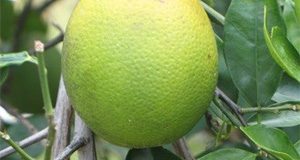
Citrus greening, or huanglongbing (HLB), is a bacterial disease that affects citrus trees’ vascular systems, limiting nutrient uptake. As trees become increasingly affected by the disease, they suffer premature fruit drop, the fruit harvested is smaller and misshapen, and the juice quality is compromised, all resulting in lower yield. To this date there is no cure or successful management strategy to deal with HLB. This 8-page fact sheet written by Ariel Singerman, Marina Burani-Arouca, and Stephen H. Futch and published by the UF/IFAS Food and Resource Economics Department summarizes the results of an analysis of three tree densities under different production and market conditions to determine which density is most profitable.
http://edis.ifas.ufl.edu/fe1050
Nematodes Parasitizing Hops in Florida
The growth of Florida’s craft beer industry has created new opportunities for Florida growers to establish commercial hop (Humulus lupulus) operations. However, many challenges including several nematode species make the establishment of this industry difficult. This 4-page fact sheet written by Johan Desaeger and published by the UF/IFAS Department of Entomology and Nematology describes nematodes that prey on hops and suggests some strategies for preventing nematode damage to safeguard this emerging industry.
http://edis.ifas.ufl.edu/in1229
Applications of Artificial Intelligence for Precision Agriculture
Technological advances in computer vision, mechatronics, artificial intelligence, and machine learning have enabled the development and implementation of remote sensing technologies for plant, weed, pest, and disease identification and management. They provide a unique opportunity for the development of intelligent agricultural systems for precision applications. This 5-page document discusses the concepts of artificial intelligence (AI) and machine learning and presents several examples to demonstrate the application of AI in agriculture. Written by Yiannis Ampatzidis, and published by the UF/IFAS Department of Agricultural and Biological Engineering, December 2018.
http://edis.ifas.ufl.edu/ae529
Calibrating Forage Seeding Equipment
Establishing forages from seeds often requires precision equipment to achieve specific seeding rates for a proper pasture stand. Most pieces of equipment have calibration charts, which are useful guides for making an initial setting. However, due to variations in seed size, purity, moisture content, equipment performance, ground speed, and other factors, calibrating equipment prior to each use is recommended. This 5-page document discusses a few calibration techniques for drills and broadcast spreaders. Written by Marcelo Wallau, Joao Vendramini, and Ed Jennings, and published by the UF/IFAS Agronomy Department, revised November 2018.
http://edis.ifas.ufl.edu/ag158
A Walk on the Wild Side: 2018 Cool-Season Forage Recommendations for Wildlife Food Plots in North Florida
Nationally, there is great interest in wildlife forages. Florida's light and sandy soils, hot and humid summers, and seasonal droughts pose unique challenges for successful food plot plantings. This 5-page document provides updated cool-season forage recommendations for wildlife food plots in north Florida. Written by A. R. Blount, M. Wallau, H. K. Ober, E. Rios, J. M. B. Vendramini, J. C. B. Dubeux, Md. A. Babar, C. L. Mackowiak, and K. H. Quesenberry, and published by the UF/IFAS Agronomy Department, revised November 2018.
http://edis.ifas.ufl.edu/ag139
